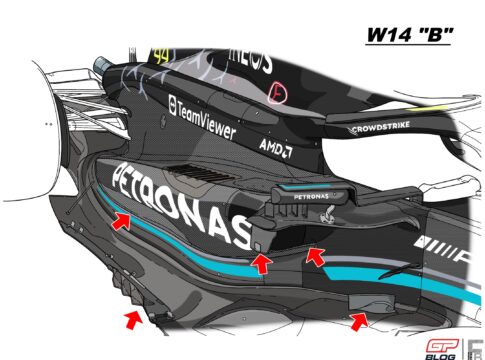In 2023, despite a challenging season with significant ups and downs and no victories, Mercedes finished second in the Constructors’ Championship by implementing three major upgrade packages to the W14, focusing on improving aerodynamic efficiency and rear stability, but still lagged behind Red Bull by almost 450 points.
Highlights
– ‣ Mercedes finished second in the Constructors’ Championship in 2023, despite a challenging season and being almost 450 points behind Red Bull. They had to compete closely with Ferrari, Aston Martin, and McLaren, without securing any victories over the 22 races.
– ‣ The W14 car initially suffered from rear instability and high drag, leading Mercedes to adopt a development path inspired by Red Bull and Aston Martin. This involved major upgrades to the sidepod and floor area, cooling inlet, and the front suspension to improve competitiveness.
– ‣ Despite significant upgrades, including a “B” version of the W14 and further updates aimed at reducing drag and improving rear stability, Mercedes struggled with performance inconsistencies throughout the season, affecting their competitiveness against leading teams.
– ‣ For 2024, Mercedes aims to focus on improving aerodynamic efficiency and rear stability, acknowledging the need to enhance the interaction between the car’s mechanics and aerodynamics to create a more stable platform across different circuit layouts and downforce configurations.
Mercedes, trailing Red Bull by nearly 450 points, clinched second in the Constructors’ Championship in 2023. It was a rollercoaster year. They kicked off with a shaky start, prompting a total rethink of their car’s design philosophy. They introduced three major upgrades to the W14, aiming to boost its competitiveness. Despite these efforts, victory eluded them across all 22 races, as they grappled with strategy blunders and fierce competition from Ferrari, Aston, and McLaren. Will 2024 see them return to their peak?
### A lot of upgrades to change the W14
The W14 was a handful from the get-go. It struggled with rear instability and high drag, particularly on circuits demanding medium to low downforce. Initially, Mercedes had evolved the 2022 car, sticking with the “zero-pod” configuration. They hoped to improve airflow to the car’s rear. Yet, this design choice led to a jittery rear end, not just in slow corners but also in the medium-speed ones. Plus, it lagged about 10 kph behind Red Bull and Ferrari on the straights.
In response, Mercedes had a backup plan inspired by Red Bull and Aston Martin’s designs, ready to ditch the zero-sidepod approach if it flopped early on. And flop it did. The first five races were underwhelming, pushing Mercedes to unveil a radically different car in Monte Carlo. The revamp touched on the sidepods, floor, and even the front suspension’s upper triangle. They tweaked the sidepod profile and cooling inlet, aiming to manage turbulence and airflow more effectively. The floor saw the addition of a flow diverter and a redesigned edge to combat negative turbulence. The front suspension adjustments aimed to improve handling during braking and fast corners.
These modifications transformed the W14, especially on high-downforce tracks. The new suspension and floor design reduced tyre wear, allowing Russell and Hamilton to shine in several races. Yet, the car still struggled with its initial downsides, prompting another update in Spa-Francorchamp. This time, the focus was on straight-line speed and minimizing rear instability. Changes to the cooling inlet, sidepod shape, and floor edge aimed to enhance aerodynamic efficiency.
Despite these efforts, the W14’s performance remained inconsistent. It excelled on high-downforce tracks but faltered in Suzuka’s mixed layout. The final update package, introduced at COTA, sought to refine the car’s performance and guide the development of the W15. This package focused on improving downforce and stability, particularly in slow corners.
### Back to winning way in 2024?
Looking ahead to 2024, Mercedes faces two critical challenges. They need to enhance aerodynamic efficiency to compete with Red Bull and Ferrari on low downforce tracks. Additionally, improving rear stability is paramount. The team’s struggle with this issue, exacerbated by the “zero-sidepod” philosophy, has persisted since 2022. Addressing these challenges will be key to Mercedes’ hopes of reclaiming their top form next season.

